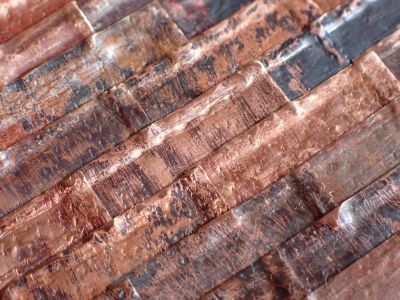Just remember, the green patina generally doesn't form without water or an extremely humid environment. Natural air oxidation turns copper into a color more like an old penny: dark brown and brassy. If you polish off all the coating on the copper strips to bare metal (the most reactive form), it will take about ten years to form something that looks more like a penny. Although it isn't a total re-creation of what one would find in a shipyard on a full scale ship n the 18th century, the penny color is what I've seen on many models in the best collections for model ships with copper bottoms.imho... why accelerate the aging process? just dont clear coat the copper... if you leave it alone long enough, it will green all by itself... and look more natural besides.
-

Win a Free Custom Engraved Brass Coin!!!
As a way to introduce our brass coins to the community, we will raffle off a free coin during the month of August. Follow link ABOVE for instructions for entering.
You are using an out of date browser. It may not display this or other websites correctly.
You should upgrade or use an alternative browser.
You should upgrade or use an alternative browser.
Copper Plating. Method for Patinating Copper Aging – I Need Your Help!
I also used the salt, vinegar (white) and ammonia method but was instructed to use an industrial strength (10%) ammonia. Depending on the ratio of each ingredient, you can push the result to the blue or green and change the texture of the finish. The attached picture is the Constructo Enterprise that I have been working on for 30 years (the instructions were about a page and a half, with a page and a half parts list.) I recently applied and antiqued the copper plate. The overall model will have a distressed look when complete.
View attachment 483174
Here is a link to the restoration of the USS Constitution. As you scroll down, you will see the museum president and the ship's CO removing a very aged copper plate from the rudder. That is what I was shooting for as far as an aged look goes. After I mixed my solution and tried it out on some new copper clad pennies, I tore strips of paper towels, soaked then in the solution and then pieced them together on the inverted hull. I was able to manipulate the saturated paper to confirm to the contour of the hull, but, the paper towel had a texture which also transferred :-(.
 print with no ink on it would have worked better. After the hull was covered with the saturated paper, I put it in a plastic bag, closed it up and put it in an outdoor shed. Would check it each day to see how it was aging and would paint more solution if it appeared to by drying out with changing the color much. The result is what you see in the picture. The results posted of many other modelers are to be commended for their appropriate scale, color and texture!
print with no ink on it would have worked better. After the hull was covered with the saturated paper, I put it in a plastic bag, closed it up and put it in an outdoor shed. Would check it each day to see how it was aging and would paint more solution if it appeared to by drying out with changing the color much. The result is what you see in the picture. The results posted of many other modelers are to be commended for their appropriate scale, color and texture!Attachments
You know, you can get patina chems at stained glass supply stores or amazon...Here is a link to the restoration of the USS Constitution. As you scroll down, you will see the museum president and the ship's CO removing a very aged copper plate from the rudder. That is what I was shooting for as far as an aged look goes. After I mixed my solution and tried it out on some new copper clad pennies, I tore strips of paper towels, soaked then in the solution and then pieced them together on the inverted hull. I was able to manipulate the saturated paper to confirm to the contour of the hull, but, the paper towel had a texture which also transferred :-(.print with no ink on it would have worked better. After the hull was covered with the saturated paper, I put it in a plastic bag, closed it up and put it in an outdoor shed. Would check it each day to see how it was aging and would paint more solution if it appeared to by drying out with changing the color much. The result is what you see in the picture. The results posted of many other modelers are to be commended for their appropriate scale, color and texture!
View attachment 487410View attachment 487410
I really like your style. It's just that in my case it will be too rippled. In my scale the plates are not big and the surface is much bigger and therefore it will take up too much attention. By the way, I still haven't found a suitable option. The product I bought doesn't work the way I want it to... and that just upsets me((View attachment 487514
I know that @serikoff isn't looking for anything as impressionist (gnarly) as my coppering style and methods but I’m posting a link for anyone who might be.
- Joined
- Jun 29, 2024
- Messages
- 1,416
- Points
- 393

Photo below shows a copper patina that I used for the base of my longboat model. The idea was to create an impressionistic appearance of water. The two brass pedestals that I turned were treated the same way. This blends them in with the water below.
There are lots of formulae on line for producing a patina on copper. The most common ingredients are ammonia and vinegar. Salt if added supposedly adds a bluish color. Anyone who has worked with ammonia knows that it is quite volatile and the instructions that I used recommended saturating a towel with the solution and enclosing everything in an airtight box with the copper not in direct contact with the towel. The vapor from the solution does the work. I used one of those plastic tubs with a snap on lid and gave the reaction several days to work. I did add salt. I was pleased with the result. I sprayed the treated copper sheet with a coat of Testor’s Dulcote.
Of course, this won’t work for a coppered hull as no one is going to enclose it in a box. A possibility could be to patina the copper before adding it to the hull, but this could damage the adhesive backing.
It seems to me that coppering a hull with real copper is doing things the hard way. Paper could be an effective substitute. Saturated with shellac, sprayed with copper paint and attached with reliable, user friendly PVA glue.
The coppered hull could then be easily weathered with an air brush.
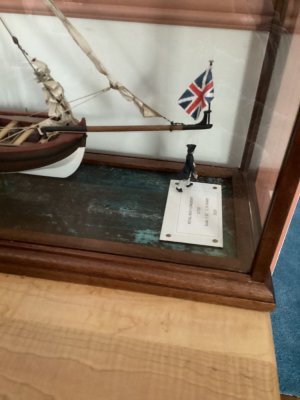
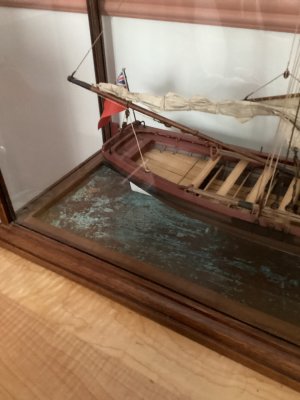
There are lots of formulae on line for producing a patina on copper. The most common ingredients are ammonia and vinegar. Salt if added supposedly adds a bluish color. Anyone who has worked with ammonia knows that it is quite volatile and the instructions that I used recommended saturating a towel with the solution and enclosing everything in an airtight box with the copper not in direct contact with the towel. The vapor from the solution does the work. I used one of those plastic tubs with a snap on lid and gave the reaction several days to work. I did add salt. I was pleased with the result. I sprayed the treated copper sheet with a coat of Testor’s Dulcote.
Of course, this won’t work for a coppered hull as no one is going to enclose it in a box. A possibility could be to patina the copper before adding it to the hull, but this could damage the adhesive backing.
It seems to me that coppering a hull with real copper is doing things the hard way. Paper could be an effective substitute. Saturated with shellac, sprayed with copper paint and attached with reliable, user friendly PVA glue.
The coppered hull could then be easily weathered with an air brush.


I suggest you use the very simple method that I used in my L'Unité model, described here in the Forum : applying salt and vinegar.I want to age the copper plating on my ship model, using the method from Dmitry Shevelev.
He used a copper-patinating solution called Patina-It. I once found it available in the U.S. at this link, but it’s no longer for sale. I’ve searched everywhere but haven’t been able to find it.
I’d greatly appreciate any help in locating this product—maybe someone in their own country has seen it, or can find it. I’d also be interested if there are any similar or alternative products available, as I’ve tried others but none achieved the same effect as Shevelev’s method, which I’ll describe below.

While I was writing this message, I found a single listing on this website, which wasn’t there until recently. The only concern is that, although the label and bottle look identical, the color of the liquid is drastically different… I’m tempted to take the risk and order it, but ideally, I’d like to find the exact same product that Shevelev used.
Here is a link where you can view a description of the patination process for copper sheathing using Dmitry Shevelev's method, within my main construction review thread.
Thank you for your assistance!
View attachment 482182
I finally found the reason why I couldn't create a patina correctly with Patina-it.
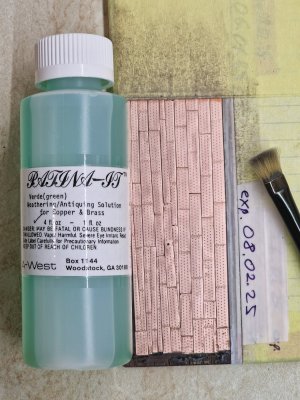
In order not to repeat the whole process, I described it here,
if you are interested, you can read it.
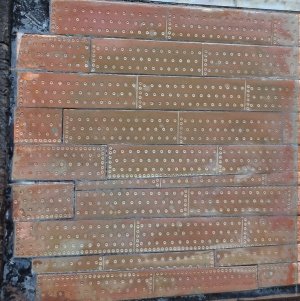
And the result is like this. On the right is the newly applied patina, on the left - a month later.
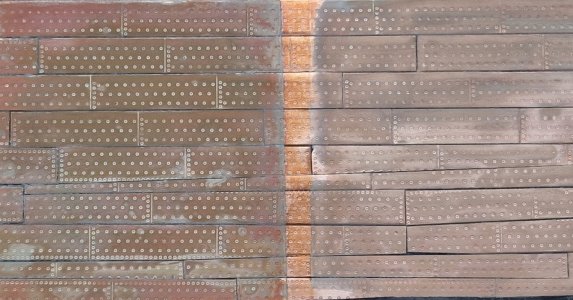
I'll post the results of today's coating in a month and see how repeatable it is. I reduced the exposure time a bit, but that should result in less patchiness, so I'm pretty close to where I'm going.


In order not to repeat the whole process, I described it here,
HMS Victory [1805] 1:79 by serikoff. Started with Mantua -> Upgraded with John McKay's Anatomy.
Phew, thank God I'm not the only one like this))))) Thank you for your support. Ukraine would definitely not have survived if it were not for the help of the entire civilized world. I will be glad to help with the construction. Unfortunately, I am far from doing everything with complete...
shipsofscale.com
if you are interested, you can read it.

And the result is like this. On the right is the newly applied patina, on the left - a month later.

I'll post the results of today's coating in a month and see how repeatable it is. I reduced the exposure time a bit, but that should result in less patchiness, so I'm pretty close to where I'm going.




